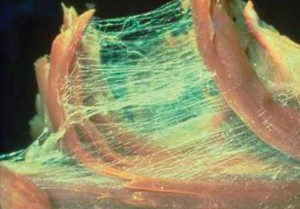By JoAnn Rahl, BCSI –


Just as we understand that we have a circulatory system or a nervous system we also have a fascial system. Our human minds like to compartmentalize the components of a system to simplify it. What would happen however if we changed our perspective and instead of seeing 640 individual muscles we saw one muscle existing in 640 fascial pockets? This is actually a more accurate representation of how our brain creates movement.
If you imagine a piece of plastic wrap that covers every inch of your body and if you crimp a portion of that plastic wrap for example on the outside of your thigh that crimp or ripple can run in a variety of directions, one being down to the bottom of your foot or in the other direction up to your hip. The fascia that is wrapped around your foot is connected to the fascia that is wrapped around your head. When you move your body to lift yourself from a seated to a standing position you are optimally using a whole fascial sheath that runs from the top of the body to the bottom, not just one group of leg muscles. Wouldn’t it be easier to learn about your body and start to work with it instead of working against it as we do when we reduce whole body movement into parts and pieces? Good posture can come from a place of force or from a place of grace and ease.
Fascial fitness is a way of exercising the whole body in movements that are initiated from the center to the circumference. Being able to move from your center however is more than just “core work” which in and of itself is important movement education. What we are working towards is a sense of kinesthetic literacy. What this means is to live in and be consciously aware of what your body is experiencing in any given moment, to be able to sense and read the movements of your body. For example how do your emotions effect your movements? If you are depressed do you round your shoulders, breathe in a shallow way, perhaps you shuffle your feet. In this culture we are accustomed to changing the brain with external forms of chemistry to affect bodily change. What might happen if we complemented the neurological and chemical therapies with structural therapy and used the body to try and change the chemistry? When connective tissue changes, breathing changes, chemistry then changes and perspective changes. The question we now want to ask is how do your movements effect your emotions? The fascial system is an organ of form, it remembers what we do and how we do it, it will replicate whatever behavior we ask it to. As we begin to practice whole body movement, kinesthetic literacy can become the new norm instead of the exception.
CONSCIOUS POSTURE | 239-777-2597 | www.consciousposture.net
 Southwest Florida's Health and Wellness Magazine Health and Wellness Articles
Southwest Florida's Health and Wellness Magazine Health and Wellness Articles
